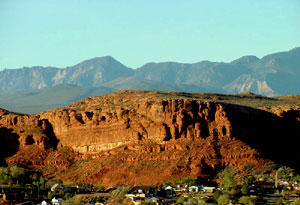 Did you know that due to St. George’s low elevation and southerly location, it is the hottest part of the state with maximum daily July temperatures averaging about 102 °F? Well it is! The hottest temperature ever recorded in Utah, 117 °F, was recorded in St. George on July 5, 1985. This was the state record until July 4, 2007, when 118 °F was recorded south of the city near the Arizona state border. The record high minimum temperature is 89 °F, set on July 15, 1970. In winter, temperatures frequently drop below freezing overnight due to radiational cooling resulting from low humidity, but temperatures generally warm up into the 50s°F during the day. Both the record low temperature of -11 °F and record low maximum temperature of 17 °F (-8 °C) were set on January 22, 1937.
Did you know that due to St. George’s low elevation and southerly location, it is the hottest part of the state with maximum daily July temperatures averaging about 102 °F? Well it is! The hottest temperature ever recorded in Utah, 117 °F, was recorded in St. George on July 5, 1985. This was the state record until July 4, 2007, when 118 °F was recorded south of the city near the Arizona state border. The record high minimum temperature is 89 °F, set on July 15, 1970. In winter, temperatures frequently drop below freezing overnight due to radiational cooling resulting from low humidity, but temperatures generally warm up into the 50s°F during the day. Both the record low temperature of -11 °F and record low maximum temperature of 17 °F (-8 °C) were set on January 22, 1937.
St. George lies in a desert and averages 8.25 inches of pre cipitation annually. Precipitation is relatively evenly distributed throughout the year, except for a dry period from late April through June. Precipitation mostly comes from the Pacific Ocean from late fall through winter and early spring. The storm track usually lifts north of the city by mid-April. The summer monsoon from the Gulf of California can bring localized but often intense thunderstorms from mid-July through mid-September. One such storm dropped the record single day precipitation in the city, with 2.39 inches on August 31, 1909. Snow is rare, averaging 3.2 inches annually. It has been recorded as early as October 29 (in 1971) and as late as April 11 (in 1927). The record single day snowfall is 10.0 in (25.4 cm), set on January 5, 1974.
cipitation annually. Precipitation is relatively evenly distributed throughout the year, except for a dry period from late April through June. Precipitation mostly comes from the Pacific Ocean from late fall through winter and early spring. The storm track usually lifts north of the city by mid-April. The summer monsoon from the Gulf of California can bring localized but often intense thunderstorms from mid-July through mid-September. One such storm dropped the record single day precipitation in the city, with 2.39 inches on August 31, 1909. Snow is rare, averaging 3.2 inches annually. It has been recorded as early as October 29 (in 1971) and as late as April 11 (in 1927). The record single day snowfall is 10.0 in (25.4 cm), set on January 5, 1974.
Now that you know a little more about our climate, come visit us in southern Utah. For more statistics on year round temperatures, you can visit www.stgeorgechamber.com/Climate.htm.
